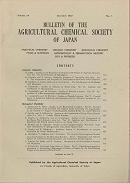22 巻, 2 号
選択された号の論文の14件中1~14を表示しています
- |<
- <
- 1
- >
- >|
-
1958 年 22 巻 2 号 p. 10
発行日: 1958年
公開日: 2008/11/27
PDF形式でダウンロード (10K) -
1958 年 22 巻 2 号 p. 63-68
発行日: 1958年
公開日: 2008/11/27
PDF形式でダウンロード (402K) -
1958 年 22 巻 2 号 p. 68-77
発行日: 1958年
公開日: 2008/11/27
PDF形式でダウンロード (551K) -
1958 年 22 巻 2 号 p. 78-84
発行日: 1958年
公開日: 2008/11/27
PDF形式でダウンロード (433K) -
1958 年 22 巻 2 号 p. 85-91
発行日: 1958年
公開日: 2008/11/27
PDF形式でダウンロード (431K) -
1958 年 22 巻 2 号 p. 91-97
発行日: 1958年
公開日: 2008/11/27
PDF形式でダウンロード (1162K) -
1958 年 22 巻 2 号 p. 98-103
発行日: 1958年
公開日: 2008/11/27
PDF形式でダウンロード (991K) -
1958 年 22 巻 2 号 p. 103-108
発行日: 1958年
公開日: 2008/11/27
PDF形式でダウンロード (397K) -
1958 年 22 巻 2 号 p. 108-116
発行日: 1958年
公開日: 2008/11/27
PDF形式でダウンロード (692K) -
1958 年 22 巻 2 号 p. 117-122
発行日: 1958年
公開日: 2008/11/27
PDF形式でダウンロード (306K) -
1958 年 22 巻 2 号 p. 123-124
発行日: 1958年
公開日: 2008/11/27
PDF形式でダウンロード (101K) -
1958 年 22 巻 2 号 p. 125-126
発行日: 1958年
公開日: 2008/11/27
PDF形式でダウンロード (649K) -
1958 年 22 巻 2 号 p. 127
発行日: 1958年
公開日: 2008/11/27
PDF形式でダウンロード (1712K) -
1958 年 22 巻 2 号 p. 128-130
発行日: 1958年
公開日: 2008/11/27
PDF形式でダウンロード (175K)
- |<
- <
- 1
- >
- >|
